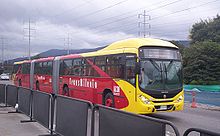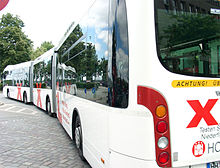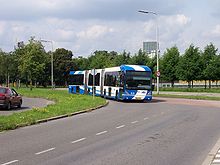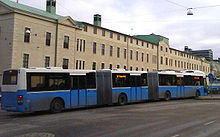- Bi-articulated bus
-
 Curitiba's bi-articulated buses and a tube-shaped bus stop, both parts of Rede Integrada de Transporte, the bus rapid transit system of Curitiba.
Curitiba's bi-articulated buses and a tube-shaped bus stop, both parts of Rede Integrada de Transporte, the bus rapid transit system of Curitiba.
 A bi-articuled bus of Transmilenio, in Bogotá, Colombia.
A bi-articuled bus of Transmilenio, in Bogotá, Colombia.
 Double articulated bus in Hamburg, Germany.
Double articulated bus in Hamburg, Germany.
A bi-articulated bus or double articulated bus is an extension of an articulated bus in that it has three passenger compartment sections instead of two. This also involves the addition of an extra axle. Due to the extended length, bi-articulated buses tend to be used on high frequency core routes or bus rapid transit schemes rather than conventional bus routes.
One of their main advantages is that they reduce the number of drivers needed to run a service for a specific number of people - i.e. it is usually much more cost-efficient to run a bi-articulated bus with one driver, than, for example, to run two smaller non-articulated buses providing the same total number of seats.
Disadvantages include some difficulties in traffic, the need to have bus stops catering to the extended length, and the fact that two buses with the same capacity can be used more flexibly, such as having one bus arrive every five minutes, instead of one of the larger articulated buses every ten minutes (as an example providing the same service capacity, but different frequencies).
Contents
Early versions
The French manufacturers Renault and Heuliez developed the "Mégabus" (officially the Heuliez GX237), a bi-articulated high-floor bus, in the late 1980s. The demonstrator Mégabus visited transit agencies throughout France, but the only city to order them was Bordeaux (for an order of 10 buses, built in 1989). These buses, now retired, operated Bordeaux's bus route 7 (most heavily-used route in Europe) until the city's Tramway de Bordeaux was built in 2004.[1]
Hungarian bus manufacturer Ikarus also developed a bi-articulated bus prototype, the Ikarus 293, in the early 1990s.[2][3]
Currently in use models
 A Van Hool bi-articulated bus in Utrecht, Netherlands
A Van Hool bi-articulated bus in Utrecht, Netherlands
 A Van Hool bi-articulated 'Bendi-Bus', in Hamburg, Germany
A Van Hool bi-articulated 'Bendi-Bus', in Hamburg, Germany
The oldest bi-articulated bus system still in use is in Curitiba, Brazil. The system began in 1992 with buses manufactured by Volvo chassis and Marcopolo/Ciferal body that can carry 270 passengers. Each bi-articulated bus is constructed with five doors where passengers can quickly load and unload. These buses (along with other bus routes in Curitiba) were the first to stop on tube stations. These stations allow passengers to pre-pay the fare and enter the vehicle at level, allowing Curitiba's bus system to be a much more affordable solution compared to subway. Curitiba has over 170 bi-articulated buses circulating the city along five major structural axis of dedicated bus lanes. These buses run on an average frequency of fifty seconds during peak hours.
The Brazilian bus body manufacturer Marcopolo and CAIO have made many bi-articulated buses on top of Volvo chassis. They are currently used in São Paulo, Campinas, Goiânia and Curitiba.
Volvo has manufactured several bi-articulated buses now in use in Gothenburg. They are based on their pusher articulated low-floor bus model with the internal combustion engine mounted on the floor on the side of the bus, and the cooling system on the roof.
The Belgian manufacturer Van Hool offers a 25 metres (82.0 ft) bi-articulated bus with a capacity of about 180 passengers. In September 2002, fifteen were deployed on lines 11 and 12 in the Dutch city of Utrecht, connecting the downtown railway station to office, college and university buildings at the edge of the city.[4] Twelve more have been added since. These buses are also used in the German cities of Aachen (lines 5 and 45) and Hamburg (Metrobus 5 and Eilbus E86), where single articulated buses alone were not able to handle the huge number of passengers per day.
Swiss Manufacturer Carrosserie Hess produces a bi-articulated Trolleybus. called LighTram that is in use in several Swiss cities, including Zürich, Geneva and Lucerne. Also, a bus with an hybrid engine based on the LighTram is offered. This type is currently in use for the Luxembourgian bus operator Voyages Emile Weber.[5]
In development projects
The Chinese manufacturer Zhejiang Youngman (Jinhua Neoplan) has developed the 25 metres (82.0 ft) JNP6250G bi-articulated bus, deemed the "world's largest", with assistance from NEOPLAN Bus GmbH. These buses are on trial service in Beijing.[6]
Bogotá's BRT system TransMilenio is currently operating bi-articulated for its most crowded corridors.
See also
- List of buses
- Trailer bus
- Road train
References
- ^ [1]
- ^ "Autobusové Noviny". http://www.autobusovenoviny.cz/clanek/935/ikarus-293. Retrieved 2010-11-12.
- ^ "Russian Wikipedia web page". http://ru.wikipedia.org/wiki/Ikarus-293. Retrieved November 2010.
- ^ "Geschiedenis in vogelvlucht" (in Dutch). Het GVU - Openbaar Vervoer in Utrecht en omgeving. http://www.gvu.nl/pages/over_gvu/geschiedenis_in_vogelvlucht.aspx. Retrieved 2007-01-07.
- ^ "News archive for Luxembourg" (in German). stadtbus.de. http://www.stadtbus2.de/nachrichten/n_archiv_ab_l.htm. Retrieved 2010-09-27.
- ^ article in Shanghai Daily - 'World's largest' bus debuts in Shanghai By Kat Jiang 2007-3-14
External links
- Photo of an early Van Hool AGG300
- Image gallery of Volvo BRT systems, some bi-articulated
- Details of the Renault Heuliez Mégabus
- Press release about introduction of Volvo bi-articulated buses in Gothenburg, Sweden
- Youngman-Neoplan China (Flash + JavaScript)
Buses List of busesConfiguration Articulated bus · Bi-articulated bus · Coach · Double-decker bus · High-floor · Lowbridge double-deck bus · Low-floor bus · Midibus · Minibus · Multi-axle bus · Open-top bus · Single-decker bus · Trailer bus · Truck busSpecial uses Advert bus · Airport bus · Armoured bus · Battle bus · Campaign bus · Party bus · Police bus · School bus · Sleeper bus · Transit bus · Training bus · Tour bus · Trolley-replica busTechnologies Manufacturing Bus manufacturing · Bus manufacturersCategory: BusesBus rapid transit Sub-articles Vehicles - Articulated bus
- Bi-articulated bus
- Guided Bus
- Guided Light Transit
- Trolleybus
- Wright StreetCar
Systems See also Categories:- Types of buses
- Articulated vehicles
Wikimedia Foundation. 2010.

